Related Research Articles

Tantra is an esoteric yogic tradition that developed on the Indian subcontinent from the middle of the 1st millennium CE onwards in both Hinduism and Buddhism.

Ravana is a demon-king of the island of Lanka and the chief antagonist in the Hindu epic Ramayana. In the Ramayana, Ravana is described as the eldest son of sage Vishrava and Kaikasi. He abducted Rama's wife, Sita, and took her to his kingdom of Lanka, where he held her in the Ashoka Vatika. Rama, with the support of vanara King Sugriva and his army of varanasi, launched a rescue operation for Sita against Ravana in Lanka. Ravana was subsequently slain, and Rama rescued his beloved wife Sita.
Tantras in Hinduism are esoteric scriptures.
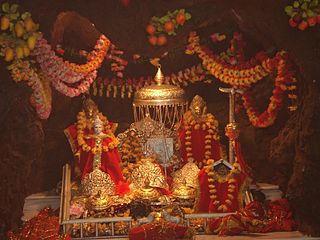
Vaishno Devi is a manifestation of the Hindu mother goddess Lakshmi in some beliefs. Vaishno Devi is worshipped as a combined avatar of the goddesses Mahakali, Mahalakshmi, and Mahasarasvati. Additionally, she is seen as the potency of Hari or Vishnu. Vaishnavi is the worshipper of Vishnu who meditates to him on the Trikut mountain and awaits his arrival.

Panchamukha, also rendered Panchamukhi, is a concept in Hindu iconography, in which a deity is represented with five heads. Several Hindu deities are depicted with five faces in their iconography, such as Hanuman, Shiva, Brahma, Ganesha, and Gayatri.

Amreli is a city and a municipality in Amreli district in Indian state of Gujarat.

Exorcism is the religious or spiritual practice of evicting demons, jinns, or other malevolent spiritual entities from a person, or an area, that is believed to be possessed. Depending on the spiritual beliefs of the exorcist, this may be done by causing the entity to swear an oath, performing an elaborate ritual, or simply by commanding it to depart in the name of a higher power. The practice is ancient and part of the belief system of many cultures and religions.
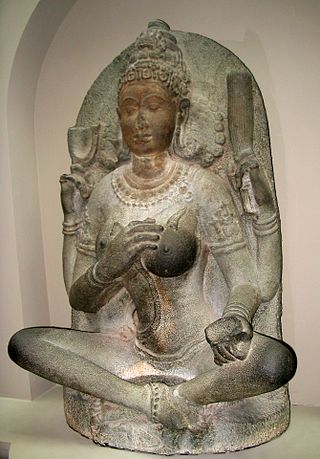
A yogini is a female master practitioner of tantra and yoga, as well as a formal term of respect for female Hindu or Buddhist spiritual teachers in the Indian subcontinent, Southeast Asia and Greater Tibet. The term is the feminine Sanskrit word of the masculine yogi, while the term "yogin" IPA:[ˈjoːɡɪn] is used in neutral, masculine or feminine sense.
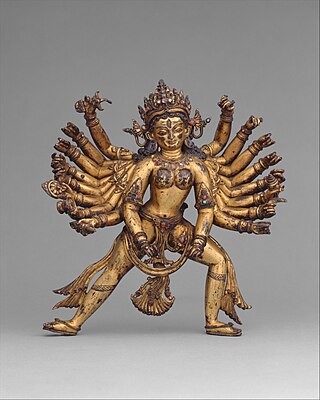
Dashain or Bada'dashain, also referred as Vijaya Dashami in Sanskrit, is a major Hindu religious festival in Nepal and the Indian states of Sikkim, West Bengal, Assam, South India, and Sri Lanka. It is also celebrated by other religions of Nepal and elsewhere in the world, including among the Lhotshampa of Bhutan and the Burmese Gurkhas of Myanmar. The festival is also referred as Nauratha, derived from the Sanskrit word for the same festival Navaratri which translates to Nine Nights.

Mehandipur Balaji Temple is a Hindu temple located in Mehandipur, Dausa district, in the Indian state of Rajasthan. The temple is dedicated to the deity Hanuman. The name Balaji refers to the childhood form of Hanuman, revered in several parts of the country. Unlike similar religious sites, it is located in a town rather than the countryside. Its reputation for ritualistic healing and exorcism of evil spirits attracts many pilgrims from Rajasthan and elsewhere.

Shri Peetambra Peetha is a complex of Hindu temples, located in the city of Datia, in the Madhya Pradesh state of central India. It was, according to many legends 'Tapasthali' of many mythological as well as real life people. The Shivling of shree Vankhandeswar Shiva is alleged to be from the times of Mahabharata. It is primarily a Shaktipeeth place of worship . Many people come here for worship on Saturday, there is the biggest crowd here.

In Hinduism, the yatra (pilgrimage) to the tirthas has special significance for earning the punya needed to attain the moksha (salvation) by performing the darśana, the parikrama (circumambulation), the yajna, the Dhyana, the puja (worship), the prarthana, the dakshina, the seva, the bhandara, etc. These sacred places are usually located on the banks of sacred waters, such as sacred rivers or their tributaries, the kundas, the ghats, or the stepwells, or the temple tanks.
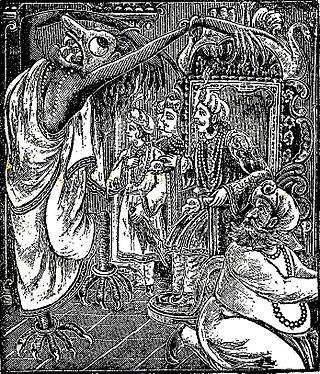
Ghosts are an important and integral part of the folklore of the socio-cultural fabric of the geographical and ethno-linguistic region of Bengal which presently consists of Bangladesh and the Indian states of West Bengal and Tripura. Bengali folktales and Bengali cultural identity are intertwined in such a way that ghosts depicted reflect the culture it sets in. Fairy tales, both old and new, often use the concept of ghosts. References to ghosts are often found in modern-day Bengali literature, cinema, radio and television media. There are also alleged haunted sites in the region. The common word for ghosts in Bengali is bhoot or bhut. This word has an alternative meaning: 'past' in Bengali. Also, the word Pret is used in Bengali to mean ghost. In Bengal, ghosts are believed to be the unsatisfied spirits of human beings who cannot find peace after death or the souls of people who died in unnatural or abnormal circumstances like murders, suicides or accidents. Non-human animals can also turn into ghosts after their death. But they are often associated with good luck and wealth in Bangladesh.

Kalaratri is the seventh of the nine Navadurga forms of the goddess Mahadevi. She is first referenced in the Devi Mahatmya. Kalaratri is one of the fearsome forms of the goddess.

Vishvaksena or Vishwaksena, is the commander-in-chief of the army of the Hindu deity Vishnu, additionally serving as a gatekeeper and chamberlain of his celestial abode of Vaikuntha. As the embodiment of the tantras, Vishvaksena is worshipped before any ritual or function in the Vaikhanasas and Sri Vaishnavism sects. He occupies an important place in Vaikhanasa and Pancaratra temple traditions, where temple festivals often begin with his worship and procession.
Shava sadhana is a Tantric sadhana in which the practitioner sits on a corpse for meditation. Shava sadhana is part of the vamachara ('heterodox') practice of worship, which is followed by the esoteric Tantra.
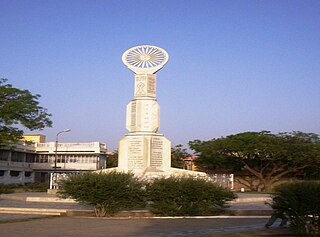
Hindaun is a Block in Karauli district of the Indian state of Rajasthan in Northern India. It is a subdivisional headquarter. Its population is approximately 442,000. The block covers an area of 700 Square kilometres, which makes it the biggest block in Karauli. The subdistrict code of Hindaun Block is 00522. There are about 165 villages in Hindaun Block.

Shri Shri 1008 Siya-Ram Bhakt Mahavir Balaji Mandir is a noted Hindu temple, otherwise known as a Mandir, in the Banka district of Bihar. It is dedicated to the Hindu God Hanuman. The name Shri Shri 1008 Sitaram Bhakt Mahavir Balaji is applied to Shri Hanuman in several areas of India, because the childhood form of the Lord is especially celebrated there.

Gadharona Balaji Temple is a temple in Gadharona village near Landhaura town of district Haridwar Uttarakhand, in which the idol of Lord Hanuman is installed. The temple is from ancient times.
References
- ↑ "Bhut | Hindu Mythology, Meaning & Ghost". Britannica . Retrieved 2024-11-06.
- ↑ Bhattacharyya, Narendra Nath (2000). Indian Demonology: The Inverted Pantheon. Manohar Publishers & Distributors. ISBN 978-81-7304-309-3.
- ↑ Vishveshvar Press Varanasi. Uddish Tantra Of Ravan With Bhasha Tika Of Rameshvar Datta By Babu Baijanath Prasad Vishveshvar Press Varanasi.
- ↑ "8 temples in India known for exorcism practices". The Times of India . Retrieved 2024-11-06.
- ↑ Iwanek, Krzysztof (2018). "Gods Against Ghosts: The Exorcisms of India's Mehandipur Balaji". The Diplomat . Retrieved 2024-11-06.
- ↑ Hunt, Holly A. (2009). Emotional Exorcism: Expelling the Four Psychological Demons That Make Us Backslide. Contemporary Psychology. Santa Barbara, California: Praeger. doi:10.5040/9798400645266. ISBN 979-8-4006-4526-6.
- ↑ "Bhuta Damara Tantra (An Authoritative Tantra of Sri Krodha Bhairava Along with His Mantras, Mandal Worship Rituals and Accomplishment Rituals of Bhutinis, Yakshinis, Snake-Girls etc.) | Exotic India Art". www.exoticindiaart.com. Retrieved 2024-11-07.
- ↑ "भैरव तन्त्र रहस्य और भीषण भैरव शाबर- Bhairav Tantra Rahasya and Bhishir Bhairav Shabar | Exotic India Art". www.exoticindiaart.com. Retrieved 2024-11-07.
- ↑ hanumanji.co.in (2024-08-18). "Why Hanumanji is known as Balaji? -" . Retrieved 2024-11-07.
- ↑ Vishveshvar Press Varanasi. Uddish Tantra Of Ravan With Bhasha Tika Of Rameshvar Datta By Babu Baijanath Prasad Vishveshvar Press Varanasi.